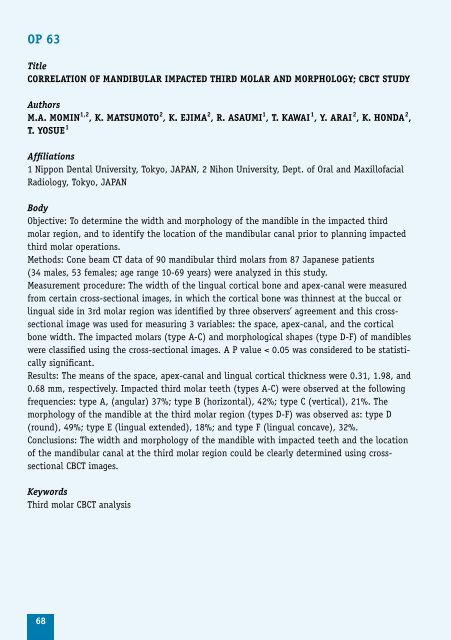Program including abstracts as pdf available here
Program including abstracts as pdf available here
Program including abstracts as pdf available here
Create successful ePaper yourself
Turn your PDF publications into a flip-book with our unique Google optimized e-Paper software.
OP 63<br />
Title<br />
CORRELATION OF MANDIbuLAR IMPACTED THIRD MOLAR AND MORPHOLOGy; CbCT STuDy<br />
Authors<br />
M.A. MOMIN 1,2 , K. MATSuMOTO 2 , K. EJIMA 2 , R. ASAuMI 1 , T. KAWAI 1 , y. ARAI 2 , K. HONDA 2 ,<br />
T. yOSuE 1<br />
Affiliations<br />
1 Nippon Dental University, Tokyo, JAPAN, 2 Nihon University, Dept. of Oral and Maxillofacial<br />
Radiology, Tokyo, JAPAN<br />
Body<br />
Objective: To determine the width and morphology of the mandible in the impacted third<br />
molar region, and to identify the location of the mandibular canal prior to planning impacted<br />
third molar operations.<br />
Methods: Cone beam CT data of 90 mandibular third molars from 87 Japanese patients<br />
(34 males, 53 females; age range 10-69 years) were analyzed in this study.<br />
Me<strong>as</strong>urement procedure: The width of the lingual cortical bone and apex-canal were me<strong>as</strong>ured<br />
from certain cross-sectional images, in which the cortical bone w<strong>as</strong> thinnest at the buccal or<br />
lingual side in 3rd molar region w<strong>as</strong> identified by three observers’ agreement and this crosssectional<br />
image w<strong>as</strong> used for me<strong>as</strong>uring 3 variables: the space, apex-canal, and the cortical<br />
bone width. The impacted molars (type A-C) and morphological shapes (type D-F) of mandibles<br />
were cl<strong>as</strong>sified using the cross-sectional images. A P value < 0.05 w<strong>as</strong> considered to be statistically<br />
significant.<br />
Results: The means of the space, apex-canal and lingual cortical thickness were 0.31, 1.98, and<br />
0.68 mm, respectively. Impacted third molar teeth (types A-C) were observed at the following<br />
frequencies: type A, (angular) 37%; type B (horizontal), 42%; type C (vertical), 21%. The<br />
morphology of the mandible at the third molar region (types D-F) w<strong>as</strong> observed <strong>as</strong>: type D<br />
(round), 49%; type E (lingual extended), 18%; and type F (lingual concave), 32%.<br />
Conclusions: The width and morphology of the mandible with impacted teeth and the location<br />
of the mandibular canal at the third molar region could be clearly determined using crosssectional<br />
CBCT images.<br />
Keywords<br />
Third molar CBCT analysis<br />
68


